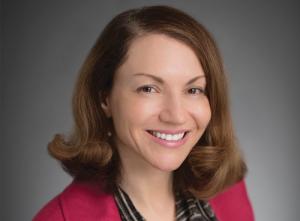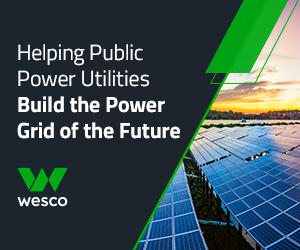Xcel Energy
Nadia El Mallakh is Area Vice President of Strategic Partnerships and Ventures, and leads Xcel Energy’s Electric Transportation Team.
PUF is excited about the Fortnightly Top Innovators 2021, because their stories are inspiring and uplifting. It's what we all need after a most trying and unusual pandemic time in our lives. It's about looking to the future and making it better.

PUF's Steve Mitnick: What's distinctive about the innovative work your team is doing in transportation?
Xcel Energy's Nadia El Mallakh: It's a comprehensive approach that we're taking. It started with our vision.
Let's go back in time to August of 2020. First summer of the pandemic, and before the new federal government administration. Before we had seen a lot of the automakers move toward commitments to phase out internal combustion engine vehicles, like we've now seen with GM, Jaguar, others.
We took a big step back asking, how do we continue the momentum with our clean energy leadership? In December of 2018, we had announced our target of eighty percent carbon reduction by 2030. And a hundred percent by 2050, on the electric side of the business. We were also thinking that transportation is now the largest source of emissions in the United States.
If the fuel of the future is our clean affordable energy, we can help. We can step up and help our communities that are asking, how do we deal with this? Because the utility industry has been making significant progress. But we haven't seen that in transportation.
So, let's put a marker out and say, we truly see this as the next frontier of our clean energy leadership. We can move the needle and greatly reduce carbon emissions from the transportation sector. And save our customers money while doing it.
That's how we ended up in August of 2020 saying, this is our vision, which is kind of an odd time if you think about it. We want 1.5 million EVs in our footprint by 2030.
That was step one. Okay, this is great, this is ambitious. But we don't make the cars. We don't sell the cars. How do we structure ourselves to make this a reality? We do it with partners because we can't do this alone. It is different than our carbon reduction targets related to Xcel Energy's generation, which we have much more control over.
Thinking about what's unique, also I would say, from the typical way we organize things in the industry and around EVs, was the creation of a five-pillar structure. We organized ourselves around key customer segments, including our residential and commercial customers, which each have a pillar. Two other pillars cover critical foundational areas of infrastructure and policy/regulatory activities.
A whole pillar of the team is focused on building strategic partnerships. With communities, manufacturers, governmental entities, and other related to EVs and beyond.
That allowed us to promote, retain, and attract some amazingly diverse candidates to the team as we grew. We were investing heavily in the team.
The EV ecosystem is diverse. We have team members from all walks of professions and life. Some worked for car manufacturers, some national retail, oil and gas, and some utilities. You name it. We have a diverse and exciting team.
When it comes to our programs, we're focused on equity and ensuring this transition is available for all our customers.
Our Colorado plan that was approved in March of this year is a great example of this. Fifteen percent of that one hundred million dollar plan is targeted toward income qualified customers.
Like rebates on a new or used car that you buy or lease. Some unique and innovative things like that. I'll stop there. I get jazzed about this.
PUF: Talk about the scale of this initiative.
Nadia El Mallakh: We worked with a lot of stakeholders to create this Colorado initiative that we been talking about. When we're all done, we will have about twenty thousand EV plugs. Some of those will be in homes, in the owner's garage.
If you live in an apartment, you should be able to get charging there. That is why we're working with multifamily housing.
And then of course there is also public charging. We have what we call EV supply infrastructure programs. Our commission has allowed us to invest beyond the meter.
We put in the infrastructure and others handle the charging. We also have the ability to own and operate some high-speed chargers and customer chargers if they so choose.
From a utility perspective, these rebates are treated as traditional utility investments. That was an important piece of the innovative regulatory framework.
PUF: You have programs to change the calculus on the part of the consumer.
Nadia El Mallakh: It's important for drivers to see charging infrastructure out there. We know that helps alleviate range anxiety.
A big piece of our portfolio is advisory and education. What we tell people is, did you know that it's the equivalent of a dollar per gallon or less to fuel up at the plug versus the pump? Their eyes get big, especially with gas prices the way they are right now.
When we reach our vision, we're going to be taking five million tons of carbon out of the environment every year, out of the transportation sector's share of emissions. That's an impressive number.
That moves a lot of folks too. I can save money out of my total energy costs, buying electrons versus fueling up at the plug, while I help reduce emissions.
There are some cool things about the cars right now. There're more models coming. There's a youth market, and a pre-owned market developing. That education, that outreach is important.
And rebates, if you do get a charger in your home, you get a five hundred dollar wiring rebate. Our customers are eligible for that. If you have to upgrade your wiring, if you're income qualified, that's thirteen hundred dollars.
PUF: You haven't been doing this program by yourself.
Nadia El Mallakh: We couldn't make it happen without the team. We were small, but mighty. Now we've grown, more than doubled our size.
One thing for sure, everyone who is on the team is a hundred percent passionate and committed to what we're doing. They are here because they love this. They see the transition to electric is the future.
They firmly believe in the benefits it's going to deliver for our communities, our customers, the environment. Even though we're all virtual still, we're having a lot of fun together.
PUF: How do you keep the team innovating and creating?
Nadia El Mallakh: We're trying to continue fostering the organic ideas from the whole team. It's not just our team. I want to give a shout out to our distribution group, operations, sourcing, contracting, business systems to name a few.
We had to bring a lot of folks with us on this journey to be able to get regulatory approvals. We just launched a suite of residential programs a few weeks ago and are planning some additional launches in September. That takes almost everyone in the company, to be quite honest, if you think about all the different parts EVs touch, to come on this journey with us.
To keep up that innovation, what we do is get together, work, and think about what's our next challenge. How do we do it better, faster, and more optimally for our customers?
The EV space is so hot right now. There are so many developments. Keeping up with all of it keeps your juices going. It's a highly competitive space. You have to stay on your toes.
Innovator conversations:
- Arizona Public Service’s Miguel Bravo, Jim Holbrook, Christine Helmuth
- California Public Utilities Commission’s Commissioner Genevieve Shiroma, Leuwam Tesfai and Forest Kaser
- CenterPoint Energy’s Eric Easton and David Mercado
- PPL’s Horst Lehmann and Eric Rosenberger
- Southern California Gas’ Eric Coene, Matt Gregori and Ron Kent
- Xcel Energy’s Nadia El Mallakh
- Top Innovators: 2021 Individuals and Teams



